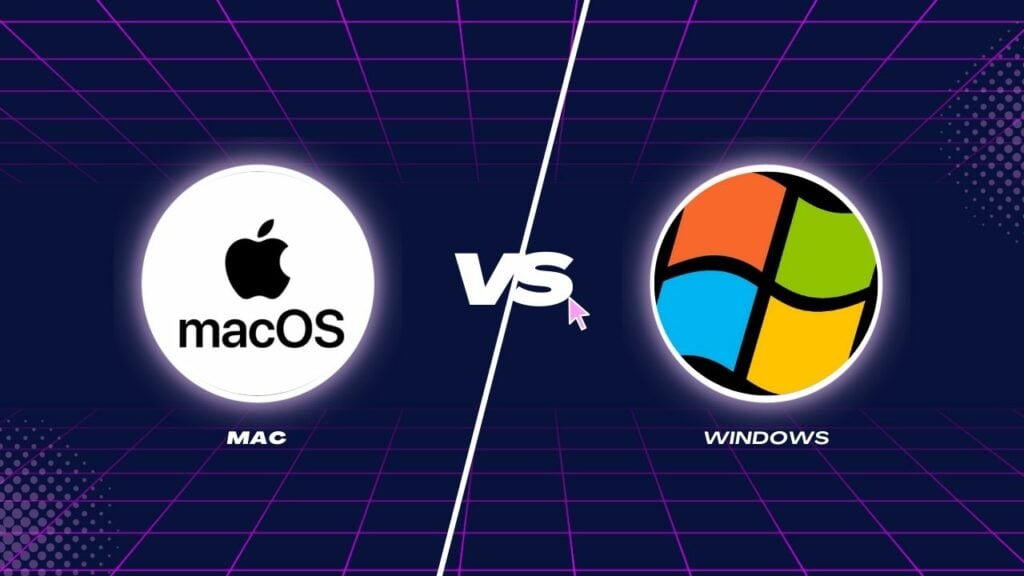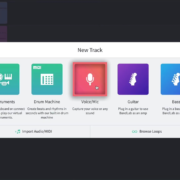For every sound you play through your interface or every knob you turn on your mixer, your operating system links your physical hardware to the drivers on your computer in the background. Your OS acts as a mediator between your hardware and software, and is a key factor in how stable your DAW and plugins perform.
The debate between Mac and Windows has always been a hot topic among computer enthusiasts. It’s no secret that more technical people prefer Macs, and that also holds true for most audio engineers and producers. The truth is that there are benefits to both. Mac is more stable and offers more compatibility with your hardware and software, whereas Windows machines are more budget friendly and you can get a lot more power for your money. In this article we’ll go over the benefits and drawbacks for both and hopefully towards the end you’ll have a clearer picture for what OS you should go with for your production needs.

Mac for Music Production
Being the most preferred OS for music production among professionals, macOS has a lot of benefits that are tailored to provide an exceptional production experience. It is a platform that has stood the test of time and provided consistent, reliable performance across the board, and there are a few reasons as to why that is.
Advantages of Mac for Music Production
1. Stability and Reliability
The most important area where macOS performs better than Windows is in their hardware-software integration. Apple requires developers to program software around their own proprietary hardware. This ensures that software for Macs are better optimized, and therefore more stable with less stutters and crashes, since they only have to work across a few devices.
Stability isn’t the only positive in this regard. With Macs, you know exactly what you’re going to get, because every similar spec Mac is identical in every way. This consistency is important for professional production where if your machine needs replacing, you can just get another one and it will reliably work just the same. The same cannot be said for Windows machines.
2. Ease-of-Use
MacOS is designed to be plug-and-play, with everything working out of the box with little or no configuration required. Windows in comparison needs more effort to get things working, which new users and less tech-savvy individuals struggle with. This also extends to drivers for your audio hardware, which won’t bug as often, settings that won’t require tweaking, and programs that are easier to install.
Macs are designed to be easy to use and require little or no technical knowledge to get started. There’s also far less troubleshooting involved on the rare occasions when something does go wrong.
3. Native Audio Processing Capabilities
Compared to Windows, macOS has a much more capable audio processing solution that runs natively without third-party workarounds. Apple’s Core Audio is a far more elegant solution for low latency audio than ASIO on Windows. While ASIO is a more efficient system, it is more restrictive than Core Audio, since it’s limited to one audio device at a time, whereas Core Audio can handle multiple devices simultaneously.
While they both work fine, Apple’s solution comes out of the box, whereas Windows requires third party assistance to get the same low latency connectivity on a more limited scale.
4. Integration with Logic Pro X and Garageband
One advantage of macOS is the addition of Mac-specific DAWs, namely Apple’s Garageband and Logic Pro. The former is completely free to use for Mac users, and provides a toned-down set of basic tools from Logic Pro in an easy-to-use, simplified form, which is great for when you’re starting out.
For a professional experience, Apple’s Logic Pro X provides a complete product with multi-input recording, higher sample rates, and more plugins and instruments than Garageband, all at a fraction of the price most Windows DAWs are priced at for more or less the same functionality.
5. Connectivity Between Apple Devices
With how few devices Apple produces and how tightly they are integrated, working on Macs has the added benefit of being able to connect to your other Apple devices seamlessly. You could be recording a rough outline of your music on your iPhone on the go, and once you’re back to your Mac, you can conveniently Airdrop your files onto your machine and continue there. Similarly, the option to handoff files and links from one device to another also helps switch smoothly between your Apple products.
Since Windows machines have to work with so many different devices from different manufacturers, neither the transition, nor the pairing is as convenient as with Mac.
Disadvantages of Mac for Music Production
1. Limited Hardware Options
While the level of integration on Mac devices is positive, the resulting limited set of hardware options is unfortunate. With Windows machines, if you have the motherboard to support it, you can slot in any component from any manufacturer and expect it to work. Apple on the other hand doesn’t provide the option for similar replacements, instead providing a handful of upgrade options that you can only opt for upfront and cannot be changed later.
With Macs, you can’t pick and choose your hardware, which puts you in a box that makes your device less flexible in terms of what you can do with it.
2. Higher Price Point
Apple products inherently come with an Apple tax, and when you purchase one, a good portion of your expense is paying for the brand name. The exceptions to this are their low-end products like the Mac Mini, and MacBook Air, which are better value products, especially for music production. That does change if you want to do more with your device however, since at similar prices Windows machines can perform better, and can be upgraded and used in other ways, like gaming and video editing.
As a general rule, Windows machines will almost always provide more bang for your buck.
3. Compatibility Issues with Third-Party Software
Windows has a far easier time with third party resources since it has a larger user base, and it’s easier to distribute on Windows than on Mac. This is exacerbated by Apple’s switch to their M1 silicon back in 2020, which required them to introduce an x86 translator, Rosetta to run those apps natively. While this is a solution, it’s by no means efficient, since the added complexity causes issues with stability, especially with third party plugins.
This limits stable and usable plugins on Macs, since some third party manufacturers can’t keep up with porting to M1 standards.
4. Upgrades Can Be Expensive
Upgrading Macs can be an expensive ordeal. This is especially difficult since everything has to be paid for upfront, with no room for upgrades down the line. Compared to Windows machines, critical production components like RAM and storage cost many times more than a Mac device. With Macs being manufactured by Apple solely, prices are less competitive than on the PC market, allowing them to charge whatever they want for upgrades.
5. Closed Ecosystem
While Apple’s closed ecosystem has its advantages, a lot of people would argue that this approach is a forced vendor lock-in, limiting the software and hardware that can be used, especially with the prices Apple demands for every piece of proprietary hardware. This is also the case with Apple locking users into their own systems and products, often punishing users for leaving their ecosystem, since their devices can’t always connect with anything that’s not Apple. There is also far less contribution from third party developers, which generally works better with open ecosystems.
While they do have their benefits, these aggressive measures sour the experience for some users.
Windows for Music Production
Being the most popular operating system, Windows has its fair share of unique selling points. While not as popular with most music production professionals, it has a large user base that prefers its affordability, performance in DAW workloads, and its larger repository of third party plugins over macOS.
Advantages of Windows for Music Production
1. Wide Range of Hardware Options
Unlike Macs, Windows devices have the option of picking from a whole slew of possible OEMs, all of whom have their own unique offerings. This makes Windows machines highly customizable since every part can be replaced with another so long as it’s compatible with the motherboard (which itself can be changed too). You can add aftermarket audio cards, GPUs, PCIe extension cards for more ports, or really anything you need,
With Windows, you can tailor your device to your exact needs, often mixed and matched between different vendors, which is something you don’t get in Macs.
2. Compatibility with Third-Party Software
Windows as a platform supports third-party development more than macOS, with some exclusives like Cakewalk Sonar that haven’t found their way to Apple’s operating system. While Windows doesn’t have support for Apple’s AAX, and AU plugins, it still provides far more options for VSTs and other plugins because it has a larger community of active developers writing programs.
Unlike Macs, which are still dependent on third party manufacturers to update their software and plugins to fit the new M1 chips, software and plugins run natively on Windows from the get-go.
3. Cheaper Price Point
Since there are so many manufacturers for Windows machines, they are priced competitively, without the inclusion of any brand-name premiums as with Apple. This makes producing on Windows more accessible on a budget, which isn’t always possible on Macs, especially on anything other than the low-end options like the Mac Mini and Macbook Air. Additionally, you can often find Windows devices, and components on sale throughout the year, which can give you an even better deal.
It is much cheaper to buy or build a much higher spec Windows machine than a Mac one, which gives you the best deal for your dollar.
4. Easy to Upgrade
Windows machines are designed to be modular, allowing you to remove and replace every component. There is a lot more freedom to expand down the line, with everything from the motherboard, processor, RAM, and storage, down to the PSU being open to upgrades. With Macs, what you buy is what you’ll have for as long as you own the machine. However, with Windows devices, you can buy a cheaper configuration to begin with, and add upgrades as needed, which is a much more economical process than paying for everything upfront.
5. Open Ecosystem
One of the reasons Windows remains so popular is for its open ecosystem. With Windows machines, support isn’t limited to a select range of hardware, and any piece of hardware that is compatible with the machine can be slotted in and used, irrespective of its manufacturer. Windows incorporates a wide variety of devices from phones, AV equipment, and other third party hardware, which can be restrictive on Macs with how heavily Apple pushes using its own recommended products
Disadvantages of Windows for Music Production
1. Reliability and Stability Issues
With the many possible combinations of hardware that can be added to Windows, there is significantly more that can go wrong, which affects stability when you’re using DAWs and plugins. Users encounter a lot more instances of errors where things don’t register, or don’t run, or freeze and crash. There’s also inconsistency with hardware, where something as simple as RAM from two manufacturers isn’t the same. This isn’t good when the machine needs replacing, since there is a chance that everything won’t work exactly as it did before.
Macs in comparison have a limited set of hardware, that is better tested and integrated with software, and can more easily be replaced with the exact same product if the device is out of order.
2. Expensive Software and Plugins
While Windows machines cost significantly less, purchasing software and plugins will cost significantly more than on Macs which have the benefit of their own macOS-specific DAWs like Garageband and Logic Pro. Depending on the type of work you do and the DAW, VSTs and plugins you use, going with Windows can cost you just as much or even more than a Mac alternative with the cost of software, effects, and instruments.
3. Limited Native Audio Processing Capabilities
Out of the box, Windows doesn’t have native audio processing as competent as on macOS. While Windows machines depend on third party solutions like ASIO for low-latency workarounds, Macs come equipped with Core Audio, which can create aggregate devices, allowing more audio equipment to be connected to your DAW without clock sync issues. This isn’t as efficient as ASIO, however, it is still superior since ASIO only supports one audio device at a time.
4. Compatibility Issues with DAWs
Since the combination of hardware on Windows machines is varied, integration isn’t as seamless as on Macs, and it shows (on some DAWs more than others). It is much easier to get a limited set of components to work perfectly than a hodgepodge of them from different manufacturers. For this reason, DAWs are much more likely to have issues with FX, VSTs, and Kontakt instruments, and are much more prone to freezing and crashing. This isn’t to say you won’t get a usable experience, there’s just a lot more that can go wrong with Windows, especially with cheap equipment.
5. Troubleshooting
Troubleshooting on Windows is a messier process than on Mac since there are a lot of different points of contact where things could have gone wrong. On Macs, issues will stem from either the OS, hardware or software. The OS and hardware can be resolved through Apple, and the software issues can be solved through the company’s support team. However, with Windows machines, troubleshooting can involve working with not only the OS and the software support team, but also tinkering with a lot of related devices all from different manufacturers that need to be solved in different ways.
While this is easier since there is a larger user base that contributes solutions, it’s still more technical than on Macs.
Technical Differences Between Mac and Windows for Music Production
A. Processor and RAM Requirements
The differences between the processor and RAM requirements can vary somewhat between Mac and Windows. Since macOS has far better integration with its hardware, it is more resource efficient, especially when considering the use of unified memory on Mac devices, which removes redundancies between CPU/GPU memory using a shared pool of RAM. Comparatively, Windows devices will require more RAM than Macs to get the same task done.
In terms of processing however, both require roughly the same requirements, i.e., a decent core count, and high base clock speeds.
B. Audio Drivers and Latency
Macs come with far better audio drivers pre-installed and have significantly less latency than Windows devices with its Core Audio. ASIO provides Windows a better third party solution with a more efficient protocol with lower buffer sizes to reduce latency, however, it restricts DAWs to one audio device at a time, which is a limitation Core Audio doesn’t have.
C. Audio File Formats
While Macs typically use the ALAC (Apple Lossless Audio Codec) audio file format, they also use AIFF, AAC, MP3, and WAV formats among others. Windows on the other hand uses WAV primarily, however, it also has support for almost all encoding formats out there.
D. Plug-In Formats
Plug-in formats differ quite a bit from macOS to Windows, where Windows primarily uses VST/VST3 plugins, but also make use of AAX/RTAS plugins which are used predominantly in Pro Tools. macOS on the other hand uses plugin formats specific to Apple platforms, such as AU which is the default for audio encoding, VST/VST3, and AAX/RTAS.
Final Words
In summation, there are a lot of merits and demerits to using both platforms for music production, however, the final verdict will boil down to your specific needs. While there is no one definitive way to produce music between them, the OS you end up choosing will determine the experience you will get, problems and all. So long as you’re comfortable with the benefits and drawbacks of your chosen option, the rest will sort itself out with experience with the platform of your choice. Whatever your choice is, it’s not a life sentence, and if you do end up changing your mind in the future, you can always make the switch.



